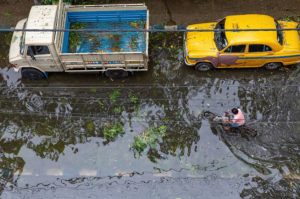Kolkata Monsoon: Kolkata reeled under chaos on Friday as a sudden, intense downpour between 1 pm and 3 pm dumped more than 107 mm of rainfall in Ballygunge alone, with Jodhpur Park recording nearly 105 mm. According to the India Meteorological Department (IMD), this rainfall figure was equivalent to nearly a week’s worth of monsoon rain in just two hours. The spell, intensified by moisture-laden easterly winds, led to widespread waterlogging across south, central, and eastern Kolkata.
Major stretches such as Lake Gardens, Dhakuria, Topsia, Ruby Crossing, and EM Bypass were submerged, with vehicles left stranded for hours. Even upscale residential neighborhoods in Gariahat and Ballygunge faced knee-deep water. With several pumping stations struggling to handle the sudden surge, the city’s fragile drainage system was pushed to the brink.

Kolkata Monsoon: Traffic Snarls and Commuter Nightmares
The heavy rains coincided with office hours, trapping commuters in gridlocks that stretched for miles. A usual 30-minute drive from New Town to PTS turned into a 90-minute ordeal, while Sector V to Chingrighata took nearly two hours.
Key arterial roads such as AJC Bose Road, Maa Flyover, and Park Circus Connector witnessed bumper-to-bumper traffic. Public buses broke down mid-route, further worsening congestion. Ride-hailing cabs either canceled trips or charged surge fares, leaving many stranded in waterlogged streets.
Several IT employees from Salt Lake Sector V complained that they were unable to return home on time. “I left my office at 5 pm and reached Tollygunge after 8:30 pm,” said Arpita Banerjee, an IT professional. “The flyovers were clogged, and every alternate road was waterlogged.”
Kolkata Police’s Traffic Department issued advisories through social media urging commuters to avoid Amir Ali Avenue, Red Road, Sarat Bose Road, and EM Bypass. However, with rain continuing intermittently till late evening, relief was minimal.
Impact Beyond Traffic: Businesses, Hospitals, and Schools Suffer
Waterlogging wasn’t just a traffic issue—it paralyzed key services:
- Hospitals like AMRI, Ruby General, and SSKM reported delayed ambulance arrivals due to flooded approach roads. Patients and attendants had to wade through water to enter the premises.
- Local businesses and roadside shops faced damage to goods as rainwater seeped inside. At Lake Market, traders reported heavy losses in vegetables and fish stocks.
- Educational institutions dismissed classes early, but many students were still caught in gridlocks. Some guardians had to walk through waterlogged roads to pick up children.
- Public transport such as auto-rickshaws and taxis were unavailable in several areas, forcing commuters to walk long distances in knee-deep water.
Monsoon Mayhem Exposes Infrastructure Gaps
Urban planners have long warned that Kolkata’s drainage system—some parts over 150 years old—is incapable of handling extreme rainfall. Local councillors highlight “no-drainage zones” like Jodhpur Park and Golf Green, where pipelines remain narrow and clogged with silt.
Despite Kolkata Municipal Corporation (KMC) deploying pumps and emergency teams, the sheer intensity of the rain overwhelmed the system. “The pumping stations have a limit of 6,000–7,000 gallons per minute, but when it rains this heavily in a short span, waterlogging is unavoidable,” a senior KMC engineer admitted.
Environmental experts also point to unplanned urbanization and shrinking wetlands, which once acted as natural buffers for stormwater. “The East Kolkata Wetlands are being encroached upon, leaving no space for excess water to drain,” noted Professor S. Chakraborty, an urban ecologist.
The Human Side: Voices from the City
Citizens, caught in the chaos, vented their frustration both offline and online:
- “It took me two hours to reach Dhakuria from Ruby. The flyover was jammed, and every shortcut was clogged. The city cannot handle monsoon anymore,” complained Debashis Ghosh, a daily commuter.
- “Water entered my shop at Topsia and damaged cartons of clothes worth ₹50,000. We face this every year, and nothing changes,” said Shafiq Ahmed, a local trader.
- “My son’s school bus got stuck for over an hour. We finally had to fetch him by wading through chest-deep water near Park Circus,” recounted Sunita Dutta, a parent.
Social media platforms like X (Twitter) and Facebook were flooded with pictures of stranded cars, people wading barefoot through flooded lanes, and sarcastic comments about Kolkata’s “annual swimming festival.”
Civic and Government Response
The KMC claimed that water had receded from most areas by late night, though complaints continued from Beliaghata, Behala, and Kalighat. Mayor Firhad Hakim assured citizens that “extra pumps are being installed and manholes are being cleared daily.”
Long-term projects are also underway:
- A ₹2,100 crore drainage overhaul in Behala, Joka, and EM Bypass, including new underground sewers and pumping stations.
- A ₹60 crore Hrishikesh Park pumping station, expected to be partially operational by September.
- Expansion of citizen grievance programs such as Amader Para Amader Samadhan, which addresses local drainage complaints at the ward level.
Climate Change and the Bigger Picture
Meteorologists warn that extreme rainfall events in Kolkata are becoming more frequent due to climate change. A study by IIT Kharagpur noted a 30% rise in short-duration, high-intensity rainfall in eastern India over the past two decades.
“Urban flooding is no longer an exception—it’s becoming a pattern,” said Dr. A. Dutta, climate researcher at IMD. “Unless cities like Kolkata upgrade their infrastructure and protect wetlands, monsoon floods will worsen.”
A Roadmap for Monsoon-Proofing Kolkata
Experts believe that beyond drainage upgrades, a multi-layered approach is necessary:
- Strict enforcement against wetland encroachment
- Creation of rainwater harvesting systems in residential and commercial complexes
- Widening of pipelines in “chronic waterlogging zones”
- Community-driven initiatives where local wards adopt green infrastructure like permeable pavements and rain gardens
Only with a mix of government investment, citizen participation, and scientific planning can Kolkata withstand the next monsoon without grinding to a halt.
External Links for Context and Insight
- Severe waterlogging, traffic movement hit across city – TOI
- Drainage overhaul in Kolkata’s low-lying areas – TOI
- East Kolkata Wetlands – Wikipedia
- IMD Weather Alerts – Official Site
Also read: Home | Channel 6 Network – Latest News, Breaking Updates: Politics, Business, Tech & More

